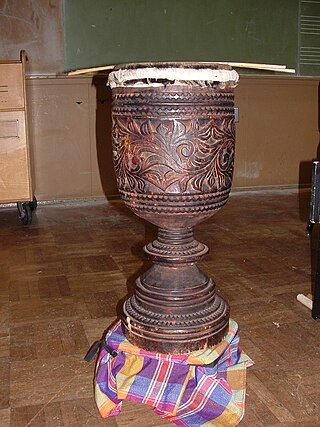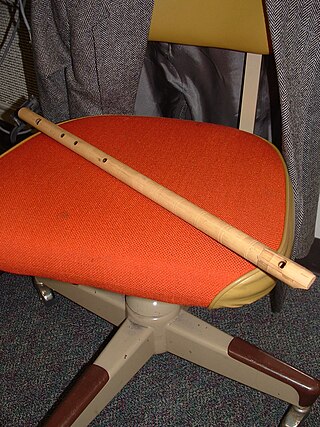
Kalinga, officially the Province of Kalinga, is a landlocked province in the Philippines situated within the Cordillera Administrative Region in Luzon. Its capital is Tabuk and borders Mountain Province to the south, Abra to the west, Isabela to the east, Cagayan to the northeast, and Apayao to the north. Kalinga and Apayao are the result of the 1995 partitioning of the former province of Kalinga-Apayao which was seen to better service the respective needs of the various indigenous peoples in the area.

The Cordillera Administrative Region, also known as the Cordillera Region and Cordillera, is an administrative region in the Philippines, situated within the island of Luzon. It is the only landlocked region in the archipelago, bordered by the Ilocos Region to the west and southwest, and by the Cagayan Valley Region to the north, east, and southeast.

The nose flute is a musical instrument often played in Polynesia and the Pacific Rim countries. Other versions are found in Africa.

The indigenous peoples of the Cordillera in northern Luzon, Philippines, often referred to by the exonym Igorot people, or more recently, as the Cordilleran peoples, are an ethnic group composed of nine main ethnolinguistic groups whose domains are in the Cordillera Mountain Range, altogether numbering about 1.8 million people in the early 21st century.

The dabakan is a single-headed Philippine drum, primarily used as a supportive instrument in the kulintang ensemble. Among the five main kulintang instruments, it is the only non-gong element of the Maguindanao ensemble.

Tinikling is a traditional Philippine folk dance which originated prior to Spanish colonialism in the area. The dance involves at least two people beating, tapping, and sliding bamboo poles on the ground and against each other in coordination with one or more dancers who step over and in between the poles in a dance. It is traditionally danced to rondalla music, a sort of serenade played by an ensemble of stringed instruments which originated in Spain during the Middle Ages. The locomotor movements used in this dance are hopping, jumping, and turning.

The kubing is a type of Philippine jaw harp from bamboo found among the Maguindanaon and other Muslim and non-Muslim tribes in the Philippines and Indonesia. It is also called kobing (Maranao), kolibau (Tingguian), aru-ding (Tagbanwa), kuribaw, aribao (Isneg), aroding (Palawan), kulaing (Yakan), ulibaw (Kalinga), karombi (Toraja), yori (Kailinese) or Kulibaw. Ones made of sugar palm-leaf are called karinta (Munanese), ore-ore mbondu or ore Ngkale (Butonese).

The tumpong is a type of Philippine bamboo flute used by the Maguindanaon, half the size of the largest bamboo flute, the palendag. A lip-valley flute like the palendag, the tumpong makes a sound when players blow through a bamboo reed placed on top of the instrument and the air stream produced is passed over an airhole atop the instrument. This masculine instrument is usually played during family gatherings in the evening and is the most common flute played by the Maguindanaon.

The Las Piñas Bamboo Organ in St. Joseph Parish Church in Las Piñas, Philippines, is a 19th-century church organ. It is known for its unique organ pipes; of its 1031 pipes, 902 are made of bamboo. It was completed after 6 years of work in 1824 by Father Diego Cera, the builder of the town's stone church and its first resident Catholic parish priest.

A kalaleng is a nose flute made from bamboo from the Philippines.

Philippine traditional musical instruments are commonly grouped into four categories: aerophones, chordophones, membranophones, and idiophones.

The pasiking is the indigenous basket-backpack found among the various ethno-linguistic groups of Northern Luzon in the Philippines. Pasiking designs have sacred allusions, although most are purely aesthetic. These artifacts, whether handwoven traditionally or with contemporary variations, are considered exemplars of functional basketry in the Philippines and among Filipinos.

Bamboo's natural hollow form makes it an obvious choice for many musical instruments. In South and South East Asia, traditional uses of bamboo the instrument include various types of woodwind instruments, such as flutes, and devices like xylophones and organs, which require resonating sections. In some traditional instruments bamboo is the primary material, while others combine bamboo with other materials such as wood and leather.
The kulibit is a type of tube zither played by the Kalinga people of the Philippines. The instrument consists of a long tube of bamboo which has been slit to allow five or six strands of the bamboo husk to be played as "strings".
The kolitong is a bamboo polychordal tube zither from Bontok, Kalinga, Philippines with six strings that run parallel to its tube body. The strings are numbered from one to six, from lowest to highest pitch. The body acts as the instrument's resonator. The body may be a whole tube or a half tube. In both cases, the two ends of the body are closed by the bamboo nodes. To help with the resonance of the instrument, holes are made on both nodes and long cracks are made along the body parallel to the strings.

The Diwas is a native bamboo wind instrument from the Philippines that is a variation of the well-known pan flute or panpipes. It is made of bamboo, with one end closed with bamboo nodes. It does not have finger holes like other popular aerophones, such as flutes. The Diwas compensates by grouping pipes of graduated lengths together. The player shifts from one pipe to another to produce sounds with varying pitches. In Kalinga, these individual pipes are known as saggeypo, which is why the Diwas is sometimes called saggeypo. The number of attached saggeypos can range from five to eight.
The paldong is a traditional lip-valley flute of the Kalinga tribes in the Philippines.

A bungkaka, also known as the bamboo buzzer is a percussion instrument (idiophone) made out of bamboo common in numerous indigenous tribes around the Philippines such as the Ifugao, Kalinga, and Ibaloi.

The tube zither is a stringed musical instrument in which a tube functions both as an instrument's neck and its soundbox. As the neck, it holds strings taut and allows them to vibrate. As a soundbox, it modifies the sound and transfers it to the open air. The instruments are among the oldest of chordophones, being "a very early stage" in the development of chordophones, and predate some of the oldest chordophones, such as the Chinese Se, zithers built on a tube split in half. Most tube zithers are made of bamboo, played today in Madagascar, India, Southeast Asia and Taiwan. Tube zithers made from other materials have been found in Europe and the United States, made from materials such as cornstalks and cactus.
















